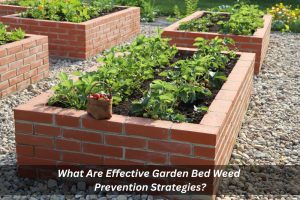Gardens are places of beauty and serenity, but there’s one persistent intruder that threatens to disrupt the harmony – weeds. These unwelcome guests can turn your once-thriving garden into a battleground. Thankfully, there are effective strategies for garden weed prevention and management in your garden bed that don’t require harmful chemicals. In this article, we’ll delve into various methods to maintain your garden’s weed-free serenity.
What are the different types of garden weeds in Sydney?
Sydney, Australia, is home to a variety of garden weeds that can plague your outdoor spaces. Understanding the types of weeds you might encounter is the first step in effective weed prevention.
- Bindii (Soliva sessilis): Bindii is known for its small, spiky seedpods, which can be painful to step on. It’s a common weed in Sydney lawns and gardens.
- Clover (Trifolium repens): While some gardeners intentionally plant clover as ground cover, it can become invasive and take over your garden if not controlled.
- Paspalum (Paspalum dilatatum): Paspalum is a fast-spreading grassy weed that’s challenging to eradicate.
- Dandelion (Taraxacum officinale): Dandelion weeds have distinctive yellow flowers and are notorious for their taproots, making them difficult to remove.
- Onion Weed (Nothoscordum borbonicum): This weed looks similar to spring onions but can quickly spread and crowd out other plants.
- Couch Grass (Cynodon dactylon): Couch grass is an aggressive grassy weed that can take over lawns and garden beds.
Knowing the enemy is the first step in devising an effective weed prevention strategy for your garden in Sydney.
How can you identify weeds in your garden bed?
To effectively combat weeds, you must first be able to identify them. Weeds can sometimes masquerade as desirable plants or hide in plain sight, so here’s how you can spot them:
- Leaf Shape: Different weeds have distinct leaf shapes. For instance, dandelion leaves are jagged and toothed, while bindii leaves are small and fern-like.
- Flowers: The appearance of flowers can also help with identification. Dandelions have bright yellow blooms, while clover produces distinctive, globe-shaped clusters of white or pink flowers.
- Growth habit: Pay attention to how the plant grows. Some weeds, like couch grass, have runners or stolons that spread quickly. Others, like onion weed, form dense clumps.
- Seed heads: The seed heads of weeds are often unique. Bindii has spiky seed heads, and paspalum produces clusters of tiny seeds.
- Roots: Digging up a plant and examining its roots can also be a useful identification technique. Dandelions, for example, have long taproots.
By becoming familiar with the characteristics of common weeds, you’ll be better equipped to spot them in your garden bed.
How can garden bed weed prevention enhance your gardening experience, and what benefits does it offer?
Garden bed weed prevention is more than just a chore; it’s an investment in the quality of your gardening experience. Here are the key benefits it offers:
- Streamlined upkeep: With a decrease in weed growth, you’ll find yourself dedicating less time and energy to the constant task of weed removal, ultimately granting you the freedom to savour your garden to the fullest.
- Healthier plants: Weeds compete with your desirable plants for water, nutrients, and sunlight. Weed prevention ensures your plants thrive.
- Aesthetic appeal: A weed-free garden bed looks more attractive and well-kept, enhancing the visual appeal of your outdoor space.
- Cost savings: You’ll spend less on weed control products and have to replace fewer plants due to weed competition.
- Environmentally friendly: Many weed prevention methods are eco-friendly, reducing your impact on the environment.
- Peace of mind: A well-maintained, weed-free garden bed provides a serene and stress-free space to relax and enjoy nature.
Incorporating weed prevention into your gardening routine enhances your overall experience, making it more enjoyable and rewarding.
What are some effective garden bed weed prevention methods?
Preventing weeds in your garden bed can save you time, effort, and frustration. Here are some effective strategies to keep those unwanted intruders at bay:
- Mulching: Applying a layer of organic mulch, like straw or wood chips, helps to smother weeds by blocking sunlight. It also retains moisture, which benefits your desirable plants.
- Weed fabric: Weed fabric, or landscape fabric, is an excellent barrier against weeds. Lay it down before planting, cutting holes for your plants, and covering it with mulch.
- Regular maintenance: Regularly inspect your garden bed and remove weeds when they’re small. This prevents them from going to seed and spreading.
- Plant density: Planting your garden densely leaves less room for weeds to grow. They need sunlight to thrive, and dense plantings can shade them out.
- Manual removal: For stubborn weeds, like dandelions, use a weeding tool to extract them, including their roots. Be thorough to prevent regrowth.
- Companion planting: Some plants, like marigolds, can help deter weeds with their natural insect-repelling properties.
- Watering techniques: To effectively manage weeds, consider watering your plants at the root rather than overhead. This approach minimizes excess moisture around weed seeds, which, in wet conditions, can significantly encourage weed growth. Additionally, you can apply this best weed controlling method to your front yard as well.
How can you remove weeds from your garden bed without using herbicides?
While herbicides can be effective, many gardeners prefer to avoid them due to environmental concerns. Here are some alternative methods for weed removal:
- Hand pulling: As mentioned earlier, manually pulling weeds is effective for small infestations. Ensure you remove the entire plant, including the roots.
- Boiling water: Pouring boiling water on weeds can kill them without harming the surrounding soil. Be cautious, as this can also affect desirable plants.
- Vinegar solution: A mixture of vinegar, salt, and a small amount of dish soap can be sprayed on weeds. This solution can damage the weed’s leaves, but it’s important to avoid spraying it on your desirable plants.
- Corn gluten meal: This organic product acts as a natural pre-emergent herbicide, preventing weed seeds from germinating. It’s safe for the environment and your garden.
- Flame weeding: Flame weeding involves using a propane torch to quickly heat and kill weeds. It’s effective for larger areas but should be used with caution to avoid fires.
- Manual tools: Tools like hoes, trowels, and weeding knives can be used to uproot weeds. These are essential for deep-rooted weeds that hand-pulling can’t remove entirely.
When should you call a professional weed removal service?
In some cases, weeds can become overwhelming, despite your best efforts. Calling in professional weed removal services may be necessary when:
- Large area infestations: If your garden bed is overrun by weeds, a professional service can quickly and effectively restore order.
- Toxic weeds: Some weeds can be toxic to humans and pets. If you’re dealing with such weeds, professional assistance is crucial to ensure safe removal.
- Invasive weeds: Invasive weeds can quickly spread to neighbouring properties, causing disputes. Professionals can handle these situations more effectively.
- Lack of time or expertise: If you don’t have the time or knowledge to tackle the problem yourself, hiring experts is a practical solution.
- Persistent perennials: Perennial weeds can be challenging to eradicate, as they return year after year. Professionals can use specialised techniques to manage these weeds effectively.
In what ways can professionals specialising in garden bed weed prevention assist you in averting weed growth?
Professional weed removal services offer more than just a quick fix. They can also help you establish long-term weed prevention strategies. Here’s how they can assist:
- Site assessment: Professionals will assess your garden and identify the specific types of weeds present. This allows them to tailor a prevention plan to your unique situation.
- Weed removal: Experts will use their knowledge and tools to efficiently remove existing weeds, including their roots.
- Preventive measures: They can recommend preventive measures like mulching, landscape fabric, and appropriate planting to reduce future weed growth.
- Regular maintenance: Some services offer ongoing maintenance to keep your garden weed-free, saving you time and effort.
- Safe practices: Professionals are knowledgeable about safe weed removal practices that won’t harm your desirable plants or the environment.
- Educational resources: Many weed removal services are happy to educate homeowners on how to identify and manage weeds on their own.
Conclusion
Maintaining a beautiful garden in Sydney is a rewarding endeavour, and effective weed prevention is key to your success. By familiarising yourself with the common weeds in the region, identifying them, and implementing various prevention strategies, you can keep your garden looking its best. If weeds become too overwhelming, don’t hesitate to seek the assistance of professional weed removal services. With the right approach, your garden can thrive, weed-free, and remain a tranquil oasis for years to come.
If you’re looking to transform your garden into a lush, weed-free haven, All Green Gardening & Landscaping is here to make that vision a reality. With our expert knowledge of Sydney’s unique weed challenges and a commitment to eco-friendly practices, we’ll help you achieve a garden that’s not only beautiful but also healthy and sustainable. Whether you need professional weed removal, landscape design, or ongoing maintenance, our dedicated team has you covered. Don’t let weeds disrupt your garden’s harmony—get in touch with us today and let us partner with you in creating the garden of your dreams. Your serene, thriving garden is just a click or call away.

